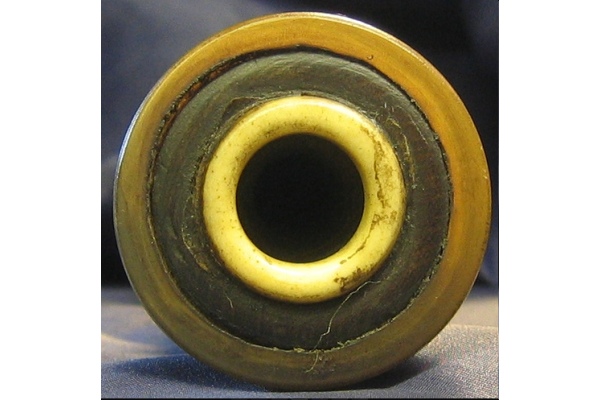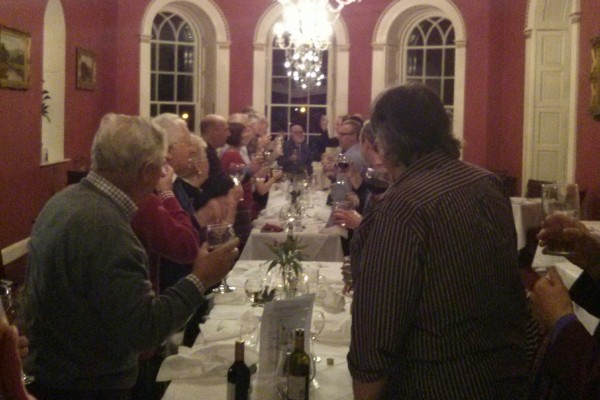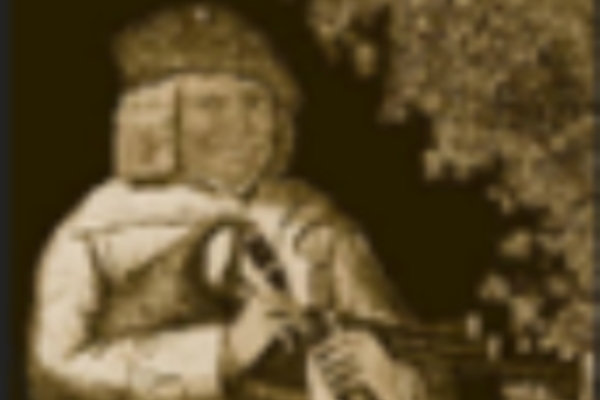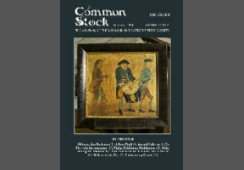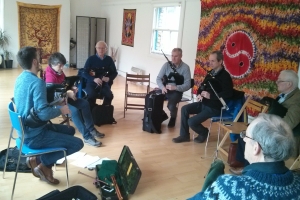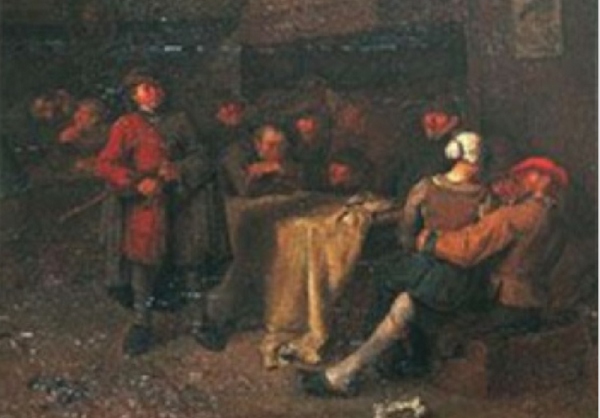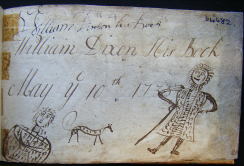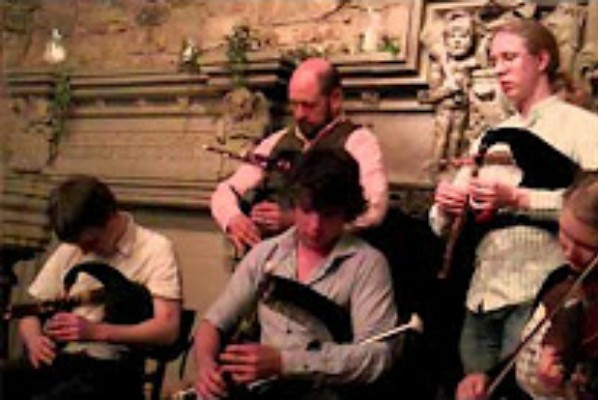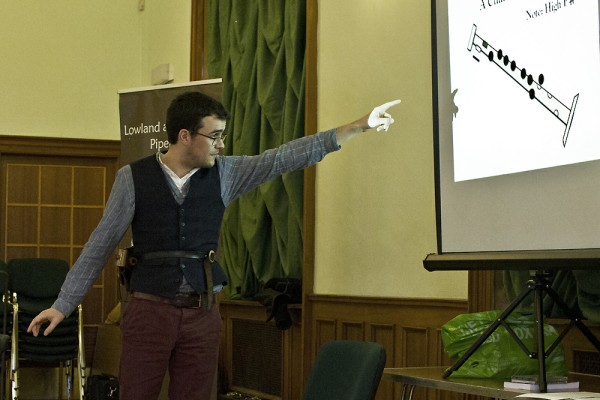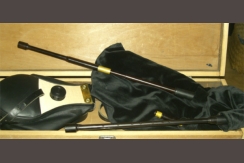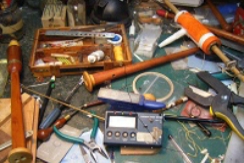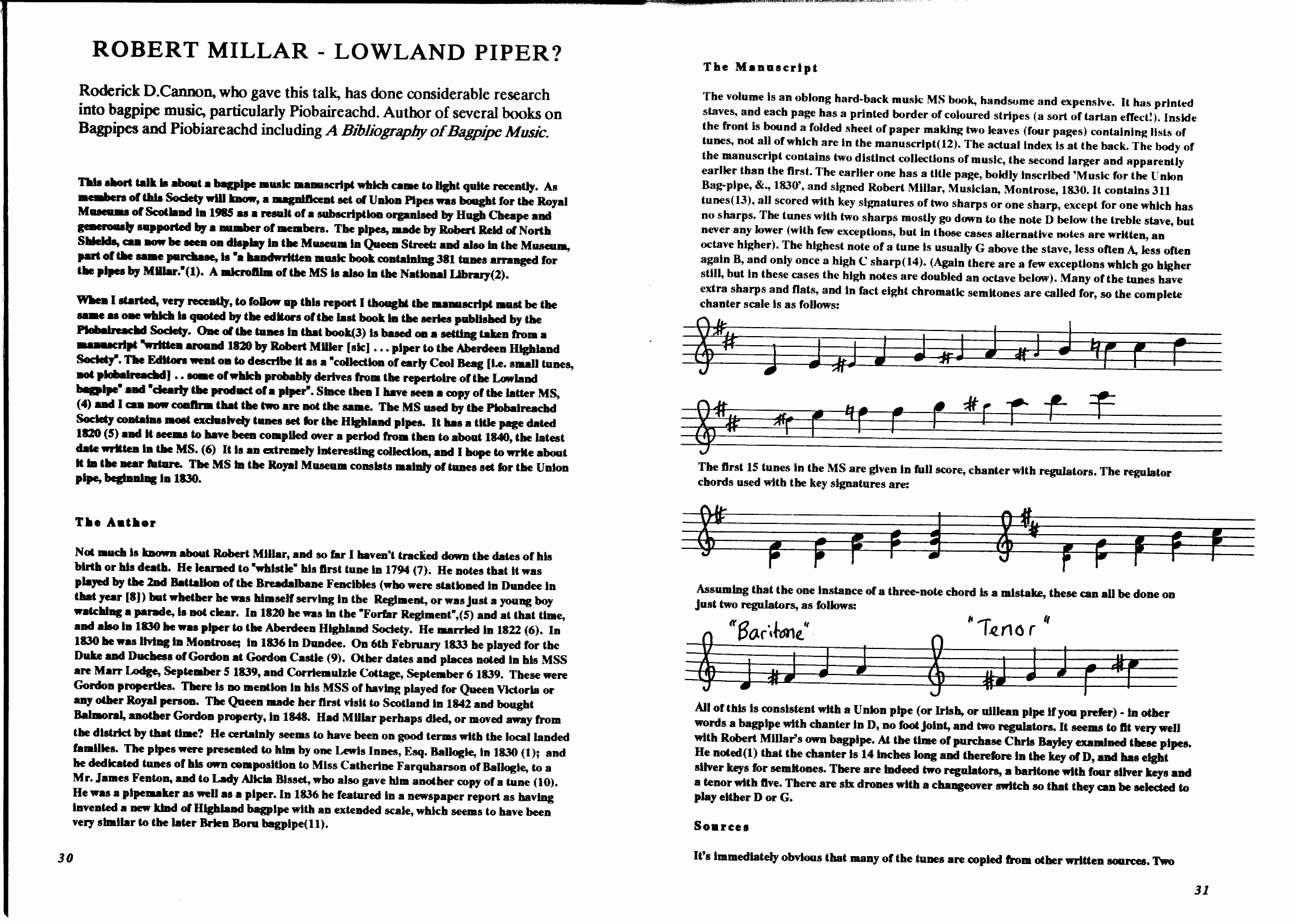
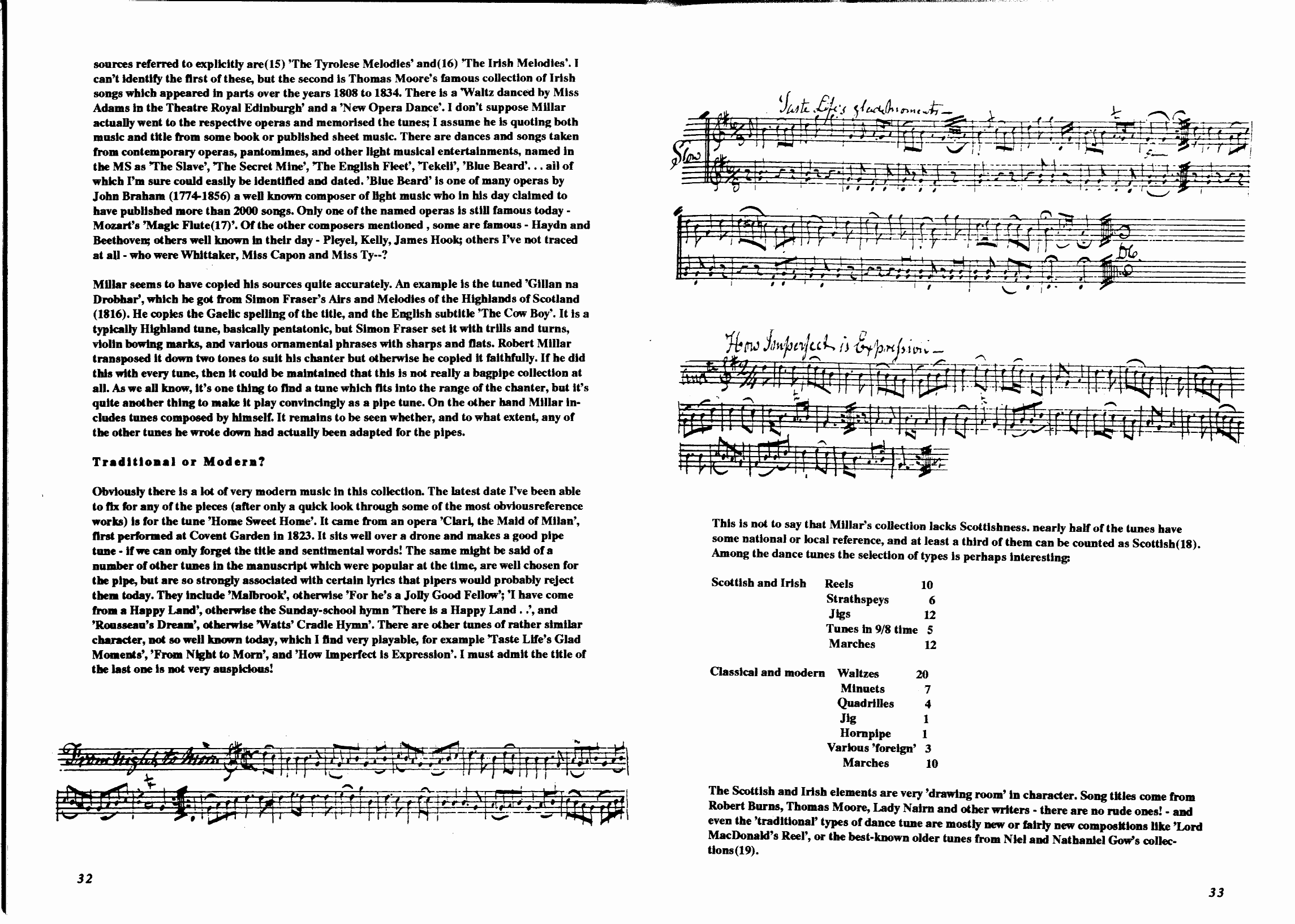
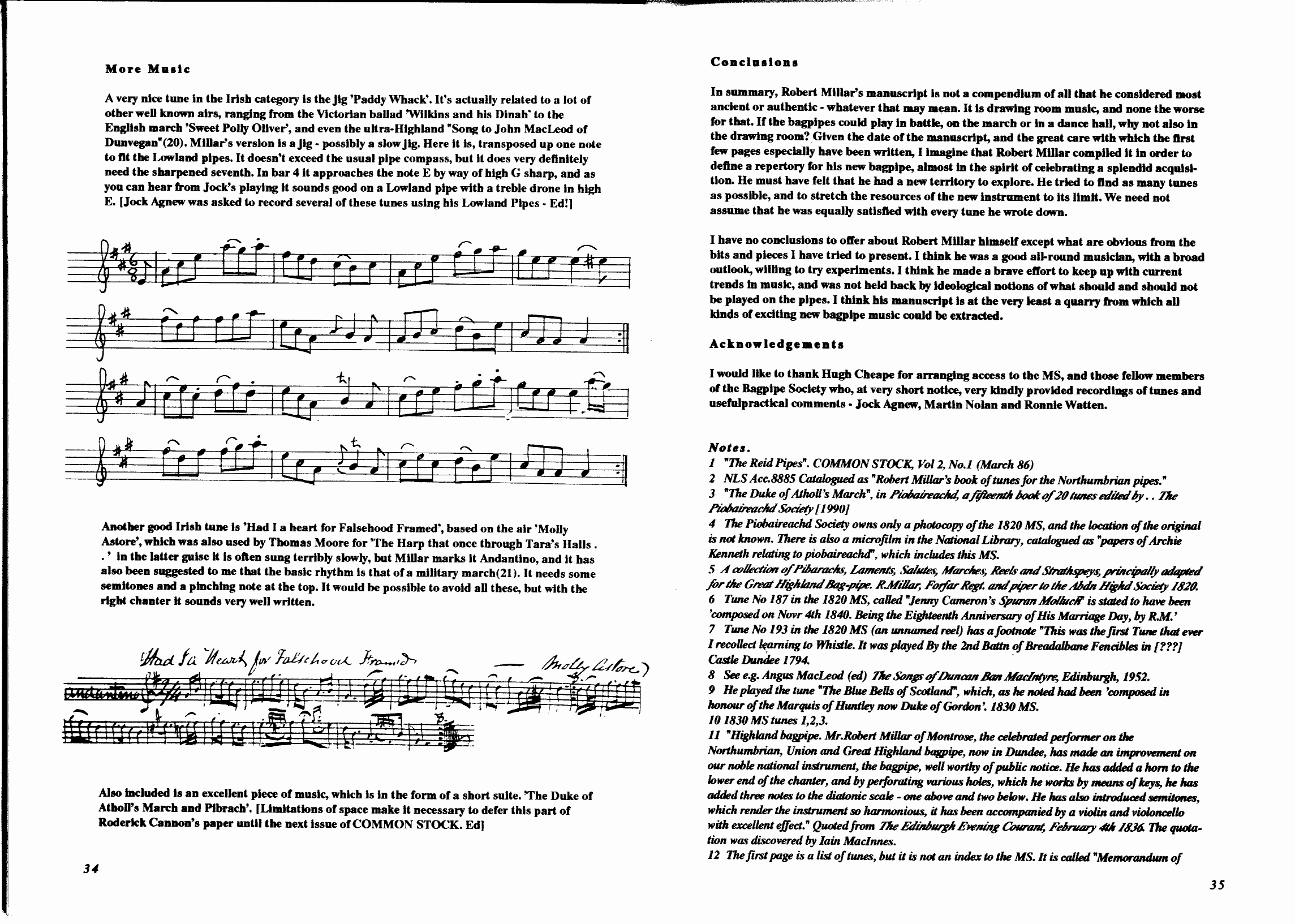
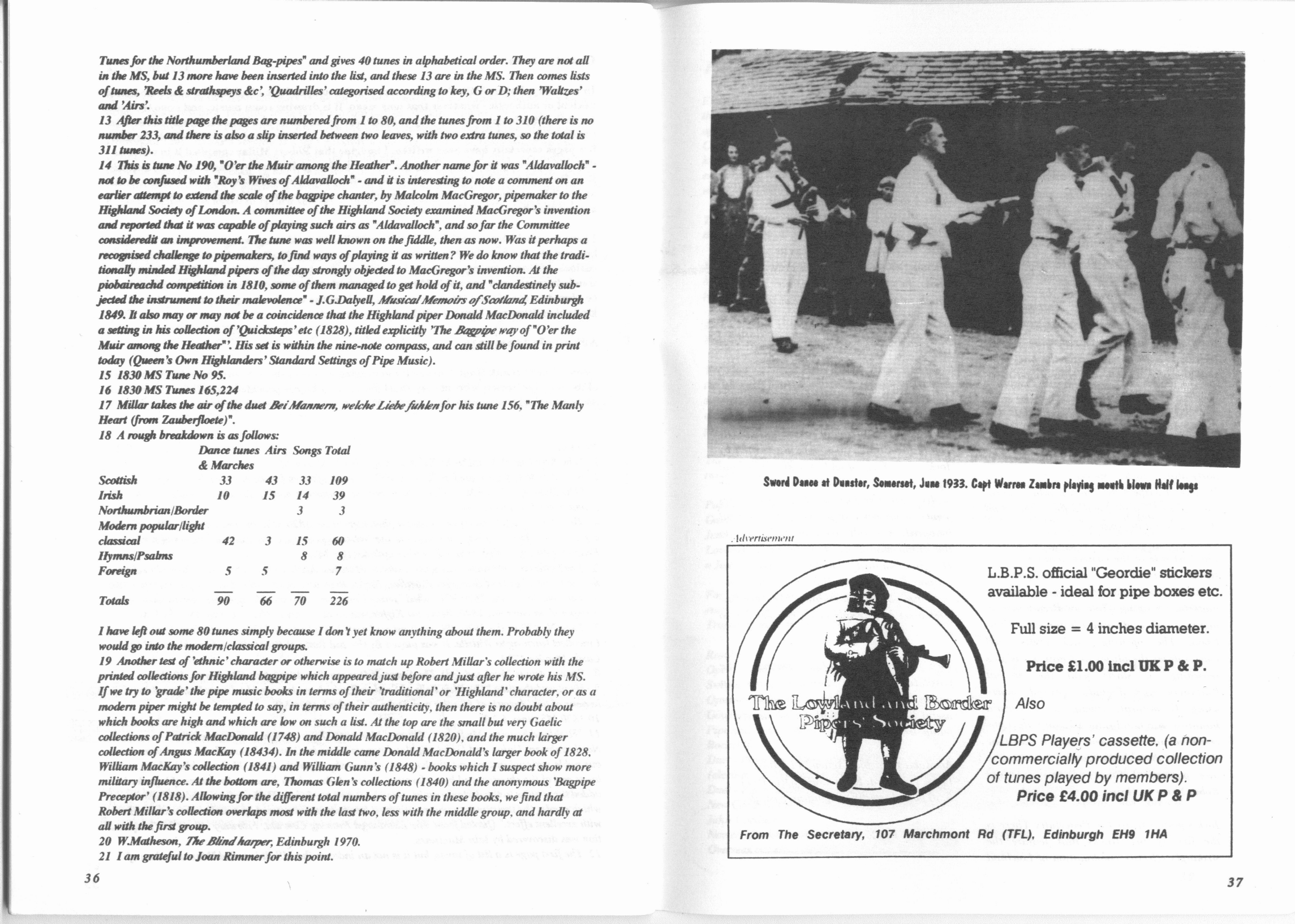
Roderick D.Cannon, who gave this talk, has done considerable research into bagpipe music, particularly Piobaireachd. Author of several books on Bagpipes and Piobiareachd including A Bibliography of Bagpipe Music.
This short talk is about a bagpipe music manuscript which came to light quite recently. As members of this Society will know, a magnificent set of Union Pipes was bought for the Royal Museums of Scotland in 1985 as a result of a subscription organised by Hugh Cheape and generously supported by a number of members. The pipes, made by Robert Reid of North Shields, can now be seen on display in the Museum in Queen Street: and also in the Museum, part of the same purchase, is "a handwritten music book containing 381 tunes arranged for the pipes by Millar."(1). A microfilm of the MS is also in the National Library(2).
When I started, very recently, to follow up this report I thought the manuscript must be the same as one which is quoted by the editors of the last book in the series published by the Piobaireachd Society. One of the tunes in that book(3) is based on a setting taken from a manuscript “written around 1820 by Robert Miller [sic] . . . piper to the Aberdeen Highland Society”. The Editors went on to describe it as a “collection of early Ceol Beag [i.e. small tunes, not piobatreachd] .. some of which probably derives from the repertoire of the Lowland bagpipe” and "clearly the product of a piper". Since then I have seen a copy of the latter MS, (4 and I can now confirm that the two are not the same. The MS used by the Piobaireachd Society contains most exclusively tunes set for the Highland pipes. It has a title page dated 1820 (5) and it seems to have been compiled over a period from then to about 1840, the latest date written in the MS. (6) It is an extremely interesting collection, and I hope to write about it in the near future. The MS in the Royal Museum consists mainly of tunes set for the Union pipe, beginning in 1830.
The Author
Not much is known about Robert Millar, and so far I haven't tracked down the dates of his birth or his death. He learned to "whistle" his first tune in 1794 (7). He notes that it was played by the 2nd Battalion of the Breadalbane Fencibles (who were stationed in Dundee in that year (8) but whether he was himself serving in the Regiment, or was just a young boy watching a parade, is not clear. In 1820 he was in the "Forfar Regiment",(5) and at that time, and also in 1830 he was piper to the Aberdeen Highland Society. He married in 1822 (6). In 1830 he was living in Montrose; in 1836 in Dundee. On 6th February 1833 he played for the Duke and Duchess of Gordon at Gordon Castle (9). Other dates and places noted in his MSS are Marr Lodge, September 5 1839, and Corriemulzle Cottage, September 6 1839, These were Gordon properties. There is no mention in his MSS of having played for Queen
Victoria or any other Royal person. The Queen made her first visit to Scotland in 1842 and bought Balmoral, another Gordon property, in 1848. Had Millar perhaps died, or moved away from the district by that time? He certainly seems to have been on good terms with the local landed families. The pipes were presented to him by one Lewis Innes, Esq. Ballogie, in 1830 (1); and he dedicated tunes of his own composition to Miss Catherine Farquharson of Ballogie, to a Mr. James Fenton, and to Lady Alicia Bisset, who also gave him another copy of a tune (10). He was a pipemaker as well as a piper. In 1836 he featured in a newspaper report as having invented a new kind of Highland bagpipe with an extended scale, which seems to have been very similar to the later Brien Boru bagpipe(11).
The Manuscript
The volume is an oblong hard-back music MS book, handsome and expensive, It has printed staves, and each page has a printed border of coloured stripes (a sort of tartan effect!). Inside the front is bound a folded sheet of paper making two leaves (four pages) containing lists of tunes, not all of which are in the manuscript(12). The actual index is at the back. The body of the manuscript contains two distinct collections of music, the second larger and apparently earlier than the first. The earlier one has a title page, boldly inscribed "Music for the Union Bag-pipe, &., 1830’, and signed Robert Millar, Musician, Montrose, 1830, It contains 311 tunes(13), all scored with key signatures of two sharps or one sharp, except for one which has no sharps. The tunes with two sharps mostly go down to the note D below the treble stave, but never any lower (with few exceptions, but in those cases alternative notes are written, an octave higher). The highest note of a tune is usually G above the stave, less often A, less often again B, and only once a high C sharp(14). (Again there are a few exceptions which go higher still, but in these cases the high notes are doubled an octave below). Many of the tunes have extra sharps and flats, and in fact eight chromatic semitones are called for, so the complete chanter scale is as follows:
(see below for images and music)
The first 15 tunes in the MS are given in full score, chanter with regulators. The regulator chords used with the key signatures are:
Assuming that the one instance of a three-note chord Is a mistake, these can all be done on just two regulators, as follows:
All of this is consistent with a Union pipe (or Irish, or uillean pipe if you prefer) - in other words a bagpipe with chanter in D, no foot joint, and two regulators. It seems to fit very well with Robert Millar’s own bagpipe. At the time of purchase Chris Bayley examined these pipes, He noted(1) that the chanter is 14 inches long and therefore in the key of D, and has eight silver keys for semitones. There are indeed two regulators, a baritone with four silver keys and a tenor with five. There are six drones with a changeover switch so that they can be selected to play either D or G.
Sources
It’s immediately obvious that many of the tunes are copied from other written sources. Two sources referred to explicitly are(15) “The Tyrolese Melodies” and(16) “The Irish Melodies”. I can’t identify the first of these, but the second is Thomas Moore’s famous collection of Irish songs which appeared in parts over the years 1808 to 1834. There is a “Waltz danced by Miss Adams in the Theatre Royal Edinburgh” and a “New Opera Dance”. I don’t suppose Millar actually went to the respective operas and memorised the tunes; I assume he is quoting both music and title from some book or published sheet music. There are dances and songs taken from contemporary operas, pantomimes, and other light musical entertainments, named in the MS as ’The Slave’, ‘The Secret Mine’, ‘The English Fleet’, ‘Tekeli’, ‘Blue Beard’, .. all of which I’m sure could easily be identified and dated. ‘Blue Beard’ is one of many operas by John Braham (1774-1856) a well known composer of light music who in his day claimed to have published more than 2000 songs. Only one of the named operas is still famous today - Mozart’s ‘Magic Flute(17)’. Of the other composers mentioned , some are famous - Haydn and Beethoven; others well known in their day - Pleyel, Kelly, James Hook; others I’ve not traced at all - who were Whittaker, Miss Capon and Miss Ty--?
Millar seems to have copied his sources quite accurately. An example is the tuned “Gillan na Drobhar”, which he got from Simon Fraser’s Airs and Melodies of the Highlands of Scotland (1816). He copies the Gaelic spelling of the title, and the English subtitle "The Cow Boy’. It is a typically Highland tune, basically pentatonic, but Simon Fraser set it with trills and turns, violin bowing marks, and various ornamental phrases with sharps and flats. Robert Millar transposed it down two tones to suit his chanter but otherwise he copied it faithfully. If he did this with every tune, then it could be maintained that this is not really a bagpipe collection at all. As we all know, it’s one thing to find a tune which fits into the range of the chanter, but it’s quite another thing to make it play convincingly as a pipe tune. On the other band Millar includes tunes composed by himself. It remains to be seen whether, and to what extent, any of the other tunes he wrote down had actually been adapted for the pipes.
Traditional or Modern?
Obviously there is a lot of very modern music in this collection. The latest date I’ve been able to fix for any of the pieces (after only a quick look through some of the most obvious reference works) is for the tune ‘Home Sweet Home’. It came from an opera ‘Clari, the Maid of Milan’ ,first performed at Covent Garden in 1823. It sits well over a drone and makes a good pipe tune - if we can only forget the title and sentimental words! The same might be said of a number of other tunes in the manuscript which were popular at the time, are well chosen for the pipe, but are so strongly associated with certain lyrics that pipers would probably reject them today. They include ‘Malbrook’, otherwise ‘For he’s a Jolly
Good Fellow’; ‘I have come from a Happy Land’, otherwise the Sunday-school hymn “There is a Happy Land ..”, and “Rousseau’s Dream”, otherwise “Watts’ Cradle Hymn”. There are other tunes of rather similar character, not so well known today, which I find very playable, for example “Taste Life’s Glad Moments”, “From Night to Morn”, and “How Imperfect is Expression”. I must admit the title of the last one is not very auspicious!
This is not to say that Millar's collection lacks Scottishness. Nearly half of the tunes have some national or local reference, and at least a third of them can be counted as Scottish(18).
Among the dance tunes the selection of types is perhaps interesting;
Scottish and Irish Reels 10
Strathspeys 6
Jigs 2
Tunes in 9/8 time 5
Marches 12
Classical and modern Waltzes 20
Minuets 7
Quadrilles 4
Jig 1
Hornpipe 1
Various ’foreign’ 3
Marches 10
The Scottish and Irish elements are very ‘drawing room’ in character. Song titles come from Robert Burns, Thomas Moore, Lady Nairn and other writers - there are no rude ones! - and even the ‘traditional’ types of dance tune are mostly new or fairly new compositions like ‘Lord MacDonald’s Reel’, or the best-known older tunes from Niel and Nathaniel Gow’s collections (19).
More Music
A good Irish tune is “I Had I a heart for Falsehood Framed”, based on the air “Molly
Astore”, which was also used by Thomas Moore for “The Harp that once through Tara’s Halls”. In the latter guise it is often sung terribly slowly, but Millar marks it Andantino, and it has also been suggested to me that the basic rhythm is that of a military march(21). It needs some semitones and a pinching note at the top. It would be possible to avoid all these, but with the right chanter it sounds very well written.
A very nice tune in the Irish category is the jig ‘Paddy Whack’. It’s actually related to a lot of other well known airs, ranging from the Victorian ballad “Wilkins and his Dinah” to the English march “Sweet Polly Oliver”, and even the ultra-Highland “Song to John MacLeod of Dunvegan”(20). Millar’s version is a jig - possibly a slow jig. Here it is, transposed up one note to fit the Lowland pipes. It doesn’t exceed the usual pipe compass, but it does very definitely need the sharpened seventh. In bar 4 it approaches the note E by way of high G sharp, and as you can hear from Jock’s playing it sounds good on a Lowland pipe with a treble drone in high E. [Jock Agnew was asked to record several of these tunes using his Lowland Pipes - Ed!]
Also included is an excellent piece of music, which is in the form of a short suite. The Duke of Atholl’s March and Pibrach’. [Limitations of space make it necessary to defer this part of Roderick Cannon’s paper until the next issue of COMMON STOCK. Ed]
Conclusions
In summary, Robert Millar’s manuscript is not a compendium of all that he considered most ancient or authentic - whatever that may mean. It is drawing room music, and none the worse for that. If the bagpipes could play in battle, on the march or in a dance hall, why not also in the drawing room? Given the date of the manuscript, and the great care with which the first few pages especially have been written, I imagine that Robert Millar compiled it in order to define a repertory for his new bagpipe, almost in the spirit of celebrating a splendid acquisition. He must have felt that he had a new territory to explore. He tried to find as many tunes as possible, and to stretch the resources of the new instrument to its limit. We need not assume that he was equally satisfied with every tune he wrote down.
I have no conclusions to offer about Robert Millar himself except what are obvious from the bits and pieces I have tried to present. I think he was a good all-round musician, with a broad outlook, willing to try experiments. I think he made a brave effort to keep up with current trends in music, and was not held back by ideological notions of what should and should not be played on the pipes. I think his manuscript is at the very least a quarry from kwhich all Kinds of exciting new bagpipe music could be extracted.
Acknowledgements
I would like to thank Hugh Cheape for arranging access to the MS, and those fellow members of the Bagpipe Society who, at very short notice, very kindly provided recordings of tunes and useful/practical comments - Jock Agnew, Martin Nolan and Ronnie Watten.
Notes.
- 1. "The Reid Pipes". COMMON STOCK, Vol 2, No.1 (March 86)
- 2. NLS Ace.8885 Catalogued as “Robert Millar’s book of tunes for the Northumbrian pipes.”
- 3. "The Duke of Atholl’s March", in Piobaireachd, a fifteenth book of 20 tunes edited by .. The Piobaireachd Society |1990]
- 4. The Piobaireachd Society owns only a photocopy of the 1820 MS, and the location of the original is not known. There is also a microfilm in the National Library, catalogued as “papers of Archie Kenneth relating to piobaireachd”, which includes this MS.
- 5. A collection of Pibarachs, Laments, Salutes, Marches, Reels and Strathspeys, principally adapted for the Great Highland Bagpipe. R Millar, Forfar Regt. and piper to the Abdn Highd Society 1820
- 6. Tune No 187 in the 1820 MS, called “Jenny Cameron’s Spuran Molhich” is stated to have been ‘composed on Novr 4th 1840. Being the Eighteenth Anniversary of His Marriage Day, by R.M.’
- 7. Tune No 193 in the 1820 MS (an unnamed reel) has a footnote “This was the first Tune that ever Trecollect learning to Whistle. It was played By the 2nd Battn of Breadalbane Fencibles in [???] Castle Dundee 1794”.
- 8. See eg. Angus MacLeod (ed) The Songs of Duncan Ban Macintyre, Edinburgh, 1952.
- 9. He played the tune “The Blue Bells of Scotland”, which, as he noted had been ’composed in honour of the Marquis of Huntley now Duke of Gordon’. 1830 MS.
- 10. 1830 MS tunes 1,2,3.
- 11. “Highland bagpipe. Mr. Robert Millar of Montrose, the celebrated performer on the Northumbrian, Union and Great Highland bagpipe, now in Dundee, has made an improvement on our noble national instrument, the bagpipe, well worthy of public notice. He has added a horn to the lower end of the chanter, and by perforating various holes, which he works by means of keys, he has added three notes to the diatonic scale - one above and two below. He has also introduced semitones, which render the instrument so harmonious, it has been accompanied by a violin and violoncello with excellent effect”. Quoted from The Edinburgh Evening Courant, February 4th 1836. The quotation was discovered by Iain MacInnes.
- 12. The first page is a list of tunes, but it is not an index to the MS. It is called
“Memorandum of Tunes for the Northumberland Bag-pipes” and gives 40 tunes in alphabetical order. They are not all in the MS, but 13 more have been inserted into the list, and these 13 are in the MS. Then comes lists of tunes, ‘Reels & strathspeys &c’, ’Quadrilles’ categorised according to key, G or D; then ‘Waltzes’ and ’Airs’.
- 13. After this title page the pages are numbered from 1 to 80, and the tunes from 1 to 310 (there is no number 233, and there is also a slip inserted between two leaves, with two extra tunes, so the total is 311 tunes).
- 14. This is tune No 190, "O'er the Muir among the Heather". Another name for it was “Aldavallock” - not to be confused with "Roy’s Wives of Aldavalloch" - and it is interesting to note a comment on an earlier attempt to extend the scale of the bagpipe chanter, by Malcolm MacGregor, pipemaker to the Highland Society of London. A committee of the Highland Society examined MacGregor’s invention and reported that it was capable of playing such airs as “Aldavalloch”, and so far the Committee considered it an improvement. The tune was well known on the fiddle, then as now. Was it perhaps a recognised challenge to pipemakers, to find ways of playing it as written? We do know that the traditionally minded Highland pipers of the day strongly objected to MacGregor’s invention. At the piobaireachd competition in 1810, some of them managed to get hold of it, and “clandestinely subjected the instrument to their malevolence” - J.G-Dalyell, Musical Memoirs of Scotland, Edinburgh 1849. It also may or may not be a coincidence that the Highland piper Donald MacDonald included a setting in his collection of ’Quicksteps’ etc (1828), titled explicitly “The Bagpipe way of “O’er the Muir among the Heather”’. His set is within the nine-note compass, and can still be found in print today, (Queen’s Own Highlanders’ Standard Settings of Pipe Music).
- 15. 1830 MS Tune No 95.
- 16. 1830 MS Tunes 165, 224
- 17. Millar takes the air of the duet Bei Mannern, welche Liebe fiuhlen for his tune 156,"The Manly Heart (from Zauberfloete)".
- 18. A rough breakdown is as follows:
Dance tunes Airs Songs Total & Marches
Scottish 33 43 33 109
Irish 10 I5 14 39 Northumbrian /Border 3 3
Modern popular /light
classical 42 3 15 60 Hymns/Psalms 8 8
Foreign 5 5 7
Totals 90 66 70 226
I have left out some 80 tunes simply because I don't yet know anything about them. Probably they would go into the modern/classical groups.
- 19. Another test of ‘ethnic’ character or otherwise is to match up Robert Millar's collection with the printed collections for Highland bagpipe which appeared just before and just after he wrote his MS.
If we try to grade the pipe music books in terms of their ‘traditional’ or ‘Highland’ character, or as a modern piper might be tempted to say, in terms of their authenticity, then there is no doubt about which books are high and which are low on such a list.
At the top are the small but very Gaelic collections of Patrick MacDonald (1748) and Donald MacDonald (1820), and the much larger collection of Angus MacKay (18434). In the middle came Donald MacDonald’s larger book of 1828, William MacKay’s collection (1841) and William Gunn’s (1848) - books which I suspect show more military influence.
At the bottom are, Thomas Glen's collections (1840) and the anonymous ‘Bagpipe Preceptor’ (1818). Allowing for the different total numbers of tunes in these books, we find that Robert Millar's collection overlaps most with the last two, less with the middle group, and hardly at all with the first group.
- 20. Matheson, The Blind Harper, Edinburgh 1970.
- 21. I am grateful to Joan Rimmer for this point.
